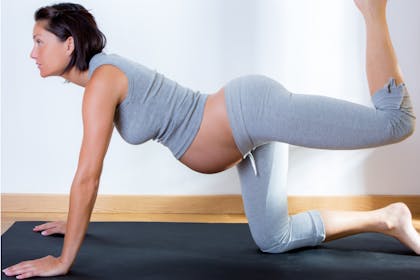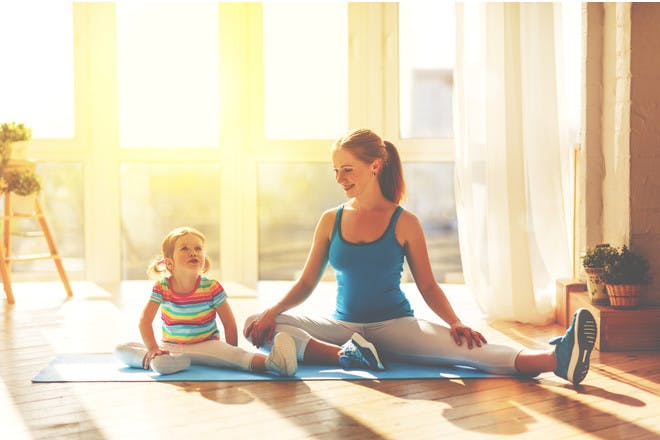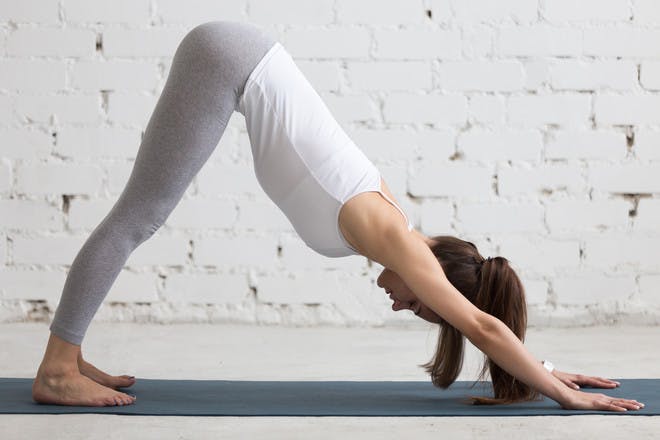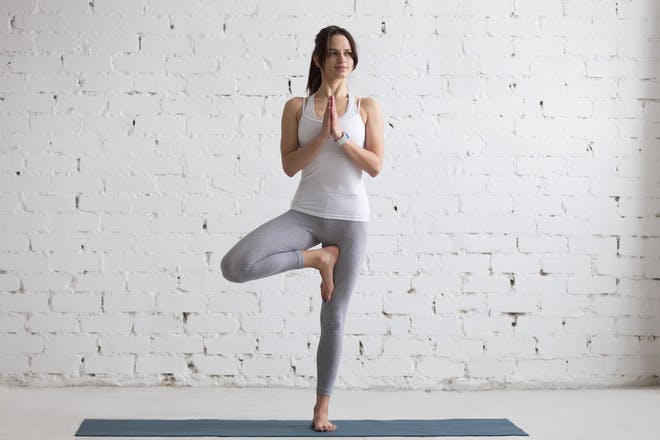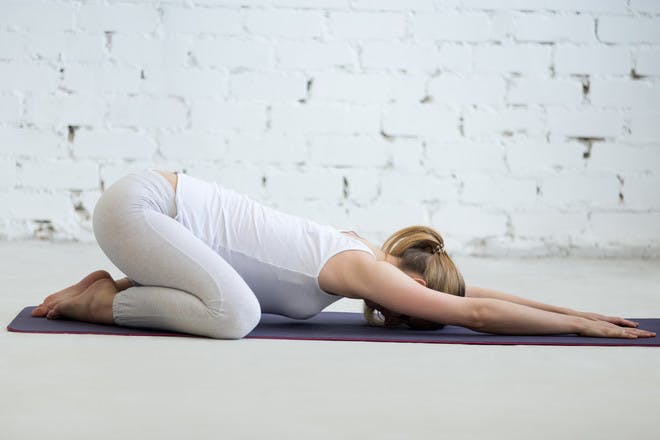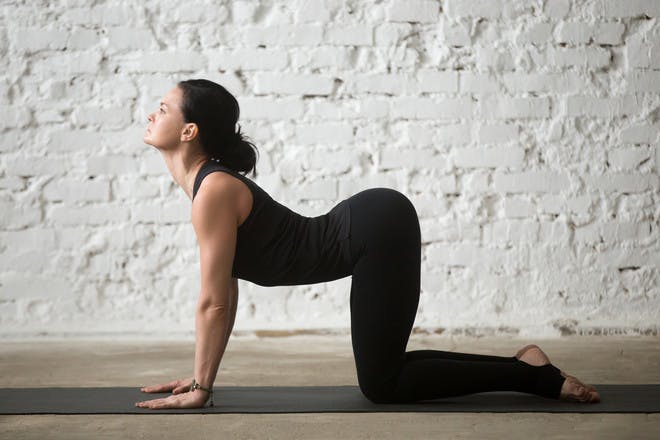Yoga is an incredibly popular form of exercise using specific poses, meditation and breathing techniques to keep you calm, focused and fit. It's also safe to start in pregnancy, helping you bond with your baby and prepare for labour and birth, too. Here's everything you need to know about doing yoga before, during and after your pregnancy.
This page contains affiliate links, which means we may earn a small amount of money if a reader clicks through and makes a purchase. All our articles and reviews are written independently by the Netmums editorial team.
What is yoga?
Yoga, which literally means ‘union’ or connected’, originated in India thousands of years ago.
It’s a form of exercise using specific yoga poses such as downward dog, cow, cat and child's pose, as well as meditation and breathing techniques.
It’s incredibly popular, with up to an estimated 30,000 yoga classes being taught each week in the UK.
FREE NEWBORN NAPPIES
Can I start yoga during pregnancy?
Yoga is suitable for almost everyone – from pregnant women and new mums through to babies and children.
The British Wheel of Yoga (the largest yoga membership organisation in the UK) recommends that pregnant women don't attend a general yoga class before reaching 15-weeks pregnant.
Before this, it recommends sticking to 'gentle breathing, relaxation and meditation'.
If you're experienced in yoga and really want to keep doing yoga in your first trimester, make sure you tell your yoga instructor that you're pregnant so that they can advise you on which poses are suitable for you.
Yoga in pregnancy or pregnancy yoga? What's the difference?
If you've already been doing general yoga classes (see below for more about different types of yoga) before getting pregnant, you can carry on with these, provided you let your teacher know that you're expecting. Or, as above, rejoin them once you reach 15 weeks.
If you happen to do a particularly strenuous form, such as hot yoga or Bikram yoga, then your instructor may recommend stopping classes completely while you are pregnant.
If you haven't done yoga before or simply want something that's very gentle, The British Wheel of Yoga recommends joining a specific pregnancy yoga class .
As the name suggests, pregnancy yoga is aimed at pregnant women and only includes poses that are safe to do.
These classes can also include pelvic floor exercises and the positions you learn can come in handy for labour, too. You'll also learn deep breathing exercises that can help you cope better with contraction pain later on.
Talk to a qualified yoga instructor about any injuries or pregnancy complications before starting any kind of yoga classes when you're pregnant.
Are any yoga poses or classes unsafe during pregnancy?
It's a good idea to avoid strenuous yoga classes such as hot yoga or Bikram yoga, particularly during your first trimester. Some instructors will recommend avoiding this form of yoga completely when you're pregnant.
According to the British Wheel of Yoga, other things to avoid include:
- Lying on your back after 16 weeks. Most yoga teachers will recommend lying on your left side for relaxation. This is for the same reasons that sleeping on your side in bed is recommended by health experts.
- Lying on your bump.
- Full inversions (ie head stands and hand stands). Shoulder stands are possible if comfortable for you.
- Poses such as back bends or twists that put too much pressure on your back or ligaments, which can be easy to overstretch during pregnancy.
- Jumping in and out of postures. This can cause injury to ligaments so step instead of jumping.
- Breathing exercises that involve holding your breath or over breathing, which can cause dizziness.
- Deep squats should be avoided, particularly in the late stages of pregnancy and in cases where the baby is in a breech position.
Make sure you tell your yoga instructor that you're pregnant and they can advise you on which poses are suitable for you.
What are the benefits of doing yoga in pregnancy?
Yoga is a total mind and body workout that can be done in a class or at home. There are lots of health benefits of doing any kind of yoga when you're pregnant, including:
- Improving flexibility, fitness and strength.
- Making you feel more relaxed and calm thanks to the breathing techniques used.
- Lowering stress levels – In one study, 85% of people who did yoga said it helped them relieve stress. Another study found that practicing regular yoga and meditation can raise your levels of the 'happiness hormone' serotonin.
- Improving your immune system – According to a study by Norwegian scientists, yoga can help boost your immune system.
- Helping with insomnia – A study by Harvard Medical School looked at the effects of yoga on insomnia and found it helped people sleep for longer, and also helped with falling asleep.
- Preparing you for labour – learning breathing exercises and positions can come in handy for staying mentally strong and pushing the baby out when you give birth. It may also help post-birth recovery, according to guidelines issued by the Pelvic Obstetric and Gynaecological Physiotherapists group (POGP).
- Increasing strength and stamina – again, useful for labour and for when you become a mum.
- Keeps heart, lungs and muscles as healthy as possible.
What are the different types of yoga?
You’ve probably heard about some of the different yoga positions, including the tree pose and warrior poses.
But as well as lot of different positions to learn, there are also lots of styles of yoga to choose from.
Here are five of the most popular:
1
Hatha yoga
Difficulty rating: easy
Hatha yoga is a gentle class and ideal for total beginners. You’ll learn the basic yoga poses and hold each pose for a few breaths.
2
Ashtanga yoga
Difficulty rating: moderate
Ashtanga yoga is more challenging than hatha yoga. You’ll do a series of yoga poses and hold each for five breaths.
3
Vinyasa yoga
Difficulty rating: moderate to hard
One of the most popular forms of yoga, Vinyasa yoga, also called Vinyasa Flow, links breathing and movement together.
Vinyasa classes have a variety of postures, meaning every class is different. This is good if you like variation in your exercise rather than doing the same poses each time.
4
Bikram yoga
Difficulty rating: hard
Bikram yoga is HOT. For the class, you’ll be in a room heated to a sweaty 40.5 degrees celsius and 40% humidity.
Every Bikram yoga class is a physical workout and contains the same 26 poses and two breathing exercises in a 90-minute session. As above, this is not recommended for during pregnancy as it's quite strenuous.
5
Pregnancy yoga
Difficulty rating: easy
Pregnancy yoga is generally a very gentle blend of yoga poses, meditation and relaxation. It can help you bond with your baby, stay in shape during pregnancy and stay relaxed during labour, too.
A beginner's guide to yoga
Watch this video below to get a sense of what pregnancy yoga's all about ...
Can you do yoga while trying to conceive (TTC)?
Yes, you can do yoga when you're trying to get pregnant.
Trying for a baby can be a really stressful time. Studies show that yoga and meditation can help reduce stress levels which can affect fertility.
Leading fertility experts including Zita West recommend doing yoga and meditation if you're trying to get pregnant . However, there is no evidence that yoga can actually help you conceive.
Some yoga instructors also advise against starting hot yoga or Bikram yoga if you're trying to get pregnant. Check with a qualified yoga instructor before taking a class.
When can you start doing yoga after having a baby?
As a new mum, you're generally advised to wait until your six-week check before you start exercising again. However, you can do very gentle exercise before this.
Most postnatal yoga classes start after this routine six week check.
You'll need to be careful with some stretches and poses – your core and back are likely to be weaker after your pregnancy.
Meanwhile the effects of pregnancy hormones can affect your joints for up to six months after birth. This means it's a good idea to wait before starting any dynamic yoga or high impact exercise.
If you're breastfeeding, feed your baby before a class. Also, remember to drink lots of fluids during and after a yoga session.
Find a postnatal yoga class near you in our local listings. You might also want to try a mother and baby yoga class.
Can I do yoga after a C-section?
If you've had a caesarean , make sure you get signed off by your doctor before starting postnatal yoga. This could be at your six-week check or longer, depending on your recovery.
Tell your yoga instructor that you've had a C-section and stop if you feel uncomfortable or if you think you're over stretching yourself.
What are the benefits of yoga once I've had the baby?
Post baby yoga is a great way to:
- relax
- do some gentle exercise
- start toning up
If you feel like doing some postnatal yoga, speak to your midwife or your GP at your six-week check, just to make sure you're ok to start exercising again.
You may even find some mum and baby yoga classes in your area, too. These are a great way to meet fellow new mums, do some gentle exercise and bond with your baby, too.
Find baby yoga classes near you, here .
If you fancy doing some postnatal yoga, this 45-minute postnatal yoga video exercise class is recommended by the NHS and is suitable for all new mums, including those who gave birth by C-section.
Find a yoga class near you
Check our local listings to find a yoga class near you .
You can also find a class through the British Wheel of Yoga , the largest yoga membership organisation in the UK.
A beginner's guide to yoga poses
Just to give you an idea of what yoga poses look and feel like, here are some of the key poses that feature in most types of yoga classes.
If you're pregnant and haven't done yoga before, it's a good idea to attend a class in person. That way, your instructor can adjust your poses and make sure you're doing them correctly.
Don't try yoga poses during pregnancy if you have any complications or injuries, without seeing your GP first.
How to do the Downward Facing Dog yoga pose
1 Start on all fours with your hands and knees on the floor and your back parallel to the floor, making sure your knees are directly below your hips and your hands are slightly forward of your shoulders.
2 Lift your knees away from the floor, exhaling as you do. Keep your legs slightly bent and your heels off the floor.
3 Exhale as you put your heels on the floor and straighten your legs (but don't lock them), forming your body into the shape of an 'A'. Make sure you keep your head between your upper arms and don't let it hang down.
4 Hold for anywhere between five and 100 breaths.
5 Exhale as you slowly bend your knees and go back to the original hands and knees position.
How to do the Tree Pose in yoga
1 Stand on both feet before shifting your weight slightly onto the left foot.
2 Keep your left foot firmly on the floor then bend your right knee, reach down with your right hand and hold your right ankle.
3 Bring your right foot up and place the sole of your foot against your left inner thigh. The centre of your pelvis should be directly over your left foot.
4 Press your hands together and hold for between 30 seconds and one minute.
How to do the Child's Pose yoga position
1 Start on your hands and knees and then spread your knees wide apart, keeping your big toes touching. Rest your bottom on your heels.
2 Sit up straight and then exhale as you bow forward until your chest is resting between or on top of your thighs. Let your forehead reach the floor.
3 Keep your arms out with your palms facing down. You can also move your arms to rest along your thighs if you want.
4 Hold for around a minute before using your hands to move your body upright again, and sit back on your heels.
How to do the Cat-Cow pose in yoga
1 Start on your hands and knees with your wrists directly beneath your shoulders, and your knees directly under your hips.
2 Move into the Cow Pose by dropping your tummy towards the floor. At the same time, lift your chin and chest and look up towards the ceiling.
3 Then move into the Cat Pose by exhaling, pulling your tummy button in and up towards your spine and round your back towards the ceiling. Tuck your chin towards your chest (but don't force it), and let your neck release.
4 Inhale, then move back to the Cow Pose before exhaling and moving back to the Cat Pose.
5 Repeat up to 20 times before sitting back on your heels.
